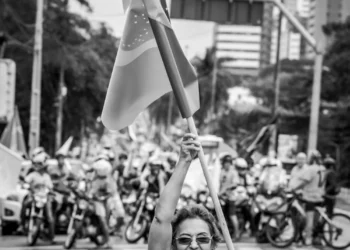by Iãkupa Apurinã* and Marcia Camargo**
Reviewed by Matheus Lucas Hebling
“My red color from urucum, my ancestors scream their essence in me, I am born from the land, I am formed by the forest, resistance, I am, I am…
I am the voice that cries, “Stop killing,” I am the voice that cries, “Stop cutting down,” I am the voice that cries, “Respect my history, respect who I am…”
I am from the forest, I belong to this land, I am pure root, eeee
I am a warrior woman, I am a true woman, and no one lowers my nose.I don’t want anything that isn’t mine; they’ve already taken the land that belonged to me. They want to make me into something I’m not, to change me from a rightful owner into an invader.
And my cry is…
Enough… enough of genocide.
Enough… enough of invasion.
Enough… enough of prejudice.
Enough… enough of denial.
Enough… enough…
I won’t give up my rights.
Enough…” (written and performed by Iãkupa Apurinã).
In this article, I explore the profound and poignant composition titled “Enough!” (original title: “Chega!”), which I penned as Iãkupa Apurinã. Through my lyrical journey, I weave together themes of identity, cultural heritage, and environmental conservation, channeling the collective voice of indigenous peoples worldwide. The song’s evocative verses touch upon the critical issues of land rights, deforestation, and the enduring struggle for respect and recognition. As I delve into the composition, I uncover the song’s symbolic resonance within the indigenous community and its broader implications for indigenous movements, environmental advocacy, and social justice.
This article not only analyzes the song’s lyrical depth but also explores its impact as a rallying cry for indigenous resilience and a call to action for a more equitable and sustainable future.
“Enough!” is more than just a song; it is a powerful anthem that encapsulates my spirit of resistance and resilience as an indigenous artist. Composed by me, Iãkupa Apurinã, deeply rooted in the Amazon rainforest, the song addresses pressing issues faced by indigenous peoples worldwide. Its verses echo the voices of those who have long fought for land rights, cultural preservation, and environmental conservation. This article offers a comprehensive analysis of the song’s lyrical and thematic elements, shedding light on its significance within the indigenous context and its broader implications for environmental advocacy and social justice. Lyrical Exploration: The song’s opening lines, “My red color from urucum, my ancestors scream their essence in me,” serve as a poignant reminder of the profound connection between indigenous peoples and their ancestral lands. The reference to urucum, a natural pigment derived from the annatto tree, symbolizes the indigenous identity deeply ingrained in the land. The lyrical journey continues as I proclaim, “I am born from the land, I am formed by the forest, resistance, I am, I am…”.
These verses celebrate the indomitable spirit of indigenous peoples, whose existence is inseparable from the natural world. The main chorus, “I am the voice that cries, ‘Stop killing,’ I am the voice that cries, ‘Stop cutting down,'” highlights the urgency of addressing critical issues such as deforestation and environmental degradation, which threaten indigenous territories and livelihoods. My song’s cry for respect, both indigenous history and individual identity, underscores the importance of acknowledging and valuing indigenous cultures and heritage. Resilience and Identity: “I am from the forest, I belong to this land, I am pure root, eeee” expresses the deep-rooted connection between indigenous communities and their ancestral territories. The reference to the purity of roots emphasizes the unbroken continuity of indigenous traditions and the strength derived from cultural heritage. The assertion, “I am a warrior woman, I am a true woman, and no one lowers my nose,” reflects the indomitable spirit and determination of indigenous women, who have historically played a pivotal role in defending their communities and cultures.
The song’s closing verses address the challenges faced by indigenous communities, including land dispossession and attempts to erode their cultural identity. The repeated chorus, “Enough… enough,” serves as a rallying cry for justice, as I proclaim, “I won’t give up my rights.”
“Enough!” is a deeply personal and impactful work, composed by me, Rosenir Fernandes de Souza, known in the iãkupa language as a “singing bird.” My identity as an Apurinã woman and a committed artist is reflected in the words of this song, which resonate not only with the struggles of indigenous peoples but also with the resilience, resistance, and determination of all those who seek justice, cultural preservation, and environmental protection.
Beyond my artistic expression, I have shared a glimpse of my multifaceted life, which encompasses my involvement with Rotary from District 4720, my active participation in Umiab (Union of Indigenous Women of the Brazilian Amazon), and the Craft Association of the Juruá Valley. Additionally, my academic journey in nursing and my role as an administrative manager in a healthcare unit for the Municipality of Rio Branco, Acre, highlight my commitment to the community and healthcare. I am also an active advocate for indigenous women in urban contexts, working tirelessly to support and empower their voices. Just as the song “Enough!” calls for respect and justice, my life and work are dedicated to these same principles, and music is just one of the many ways through which I express my identity and commitment.

I frequently use the maracá as an instrument during my singing. The Maracá is a truly special and profound instrument that transcends its musical function. For us, it represents much more than simple notes and rhythms; it is an artifact laden with spiritual significance and deep ancestral connections. While its sound guides us in the melodies and dances of our songs, the Maracá also plays a fundamental role in transforming the environment around us, granting us spiritual strength beyond words. In our traditions, music is much more than entertainment; it is a sacred tool that connects us with our ancestors, nature, and the divine. The Maracá acts as a portal to these spiritual dimensions, a channel through which we can invoke positive energies and send away any negative energies that may surround us. When we shake the Maracá, we feel a profound connection with our cultural and spiritual roots, and this connection strengthens us. Through the sound of the Maracá, we can purify our space, warding off all evils, negative energies, and obstacles that may be affecting us. It’s as if the Maracá were a spiritual shield, creating a protective aura around us. As the sound resonates, we feel inner harmony and spiritual peace that help us face life’s challenges.
Furthermore, the Maracá reminds us of the importance of preserving our traditions and sharing them with future generations. It’s a legacy that we pass on, a heritage that carries not only music but also spirituality, a connection with nature, and the strength of our culture. Therefore, the Maracá is more than just a simple instrument; it’s a link between the past and the present, between the material and the spiritual, and between the community and the divine. Our rituals and ceremonies are enriched by the sound of the Maracá, and the presence of this instrument is essential to remind us of the importance of keeping alive our beliefs, our traditions, and our connection with the spiritual world. In an increasingly hectic and challenging world, the Maracá is our spiritual refuge, our guide, and our guardian, strengthening us and warding off all evils that may come our way. In conclusion, “Chega!” (“Enough!”) is a reminder that music has the power to transcend linguistic and cultural barriers, uniting people in a shared quest for a fairer and more sustainable world. It is with this message of unity and resistance that I conclude this article, hoping that the words of this song, just like the sound of the Maracá echoing in our rituals, will continue to inspire positive actions towards a more equitable and inclusive future.
* Iãkupa Apurinã – My registered name is Rosenir Fernandes de Souza. My name in the (iãkupa) language means a singing bird. I am from the Apurinã people. I am a singer-songwriter. I am with Rotary from District 4720. I am a member of Umiab, the Union of Indigenous Women of the Brazilian Amazon. I am also part of the Craft Association of the Juruá Valley. I am an academic in nursing. I work as an administrative manager in a healthcare unit for the Municipality of Rio Branco in Acre. I am part of the women’s movement in my state, working to assist indigenous women in urban contexts.
** Marcia Camargo is a Science, Technology and Society PhD Candidate at Federal University of São Carlos and teacher and Visual Artist. Multidisciplinary Ethnographic Researcher with a decolonial collective perspective. Has kept a 10+ years partnership with the Pataxó indigenous community at Extreme South of Bahia, Brazil.
Camargo, Iãkupa Apurinã and Marcia. 2023. "Resilience and Resistance: My Indigenous Anthem". Brazilian Research and Studies Blog. ISSN 2701-4924. Vol. 4 Num. 3. Available at: https://www.bras-center.com/resilience-and-resistance-my-indigenous-anthem/, accessed on: March 10, 2025.








